Individual Assignment: Taxation Law of Australia - LAWS20060
VerifiedAdded on 2023/02/01
|12
|3194
|68
Homework Assignment
AI Summary
This document presents a comprehensive solution to an individual assignment on Australian Taxation Law (LAWS20060), likely for a university course. The assignment addresses various aspects of taxation, including depreciation, tax offsets, marginal and average tax rates, and consumption tax. It analyzes specific scenarios involving general deductions under section 8.1 of the ITAA 97, focusing on expenses related to earning taxable income, such as loan interest for employee wages, business use of mobile phones, and stolen property. The assignment also explores Capital Gains Tax (CGT) events, particularly F2 and B1, and the residential property exemption under section 118.13. It includes a CGT computation example and examines the taxability of prizes and income earned during employment, referencing relevant sections of the Income Tax Assessment Act 1997 and related rulings and case law. The solution follows the Australian Guide to Legal Citation (AGLC) 3rd Edition.
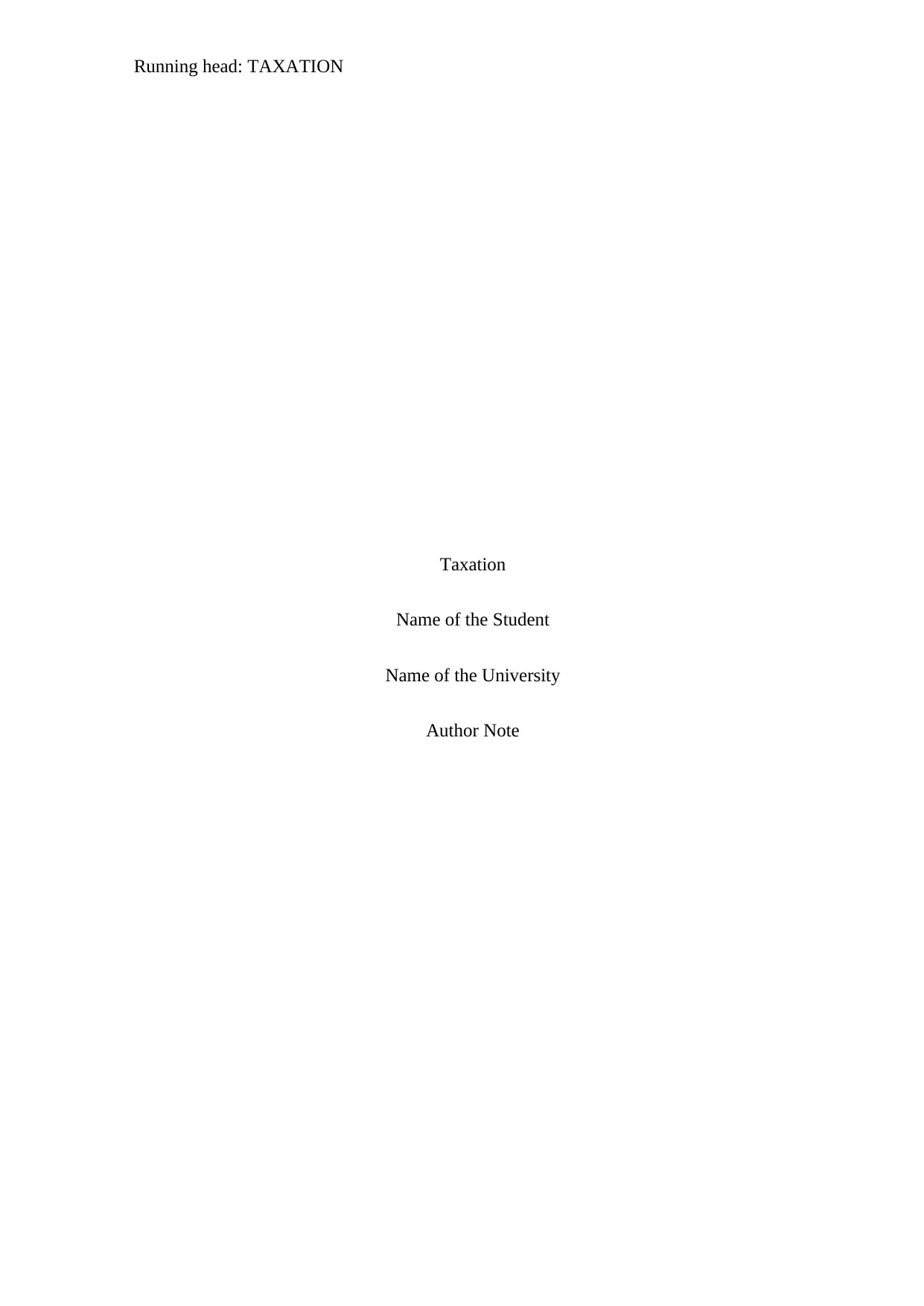
Running head: TAXATION
Taxation
Name of the Student
Name of the University
Author Note
Taxation
Name of the Student
Name of the University
Author Note
Paraphrase This Document
Need a fresh take? Get an instant paraphrase of this document with our AI Paraphraser
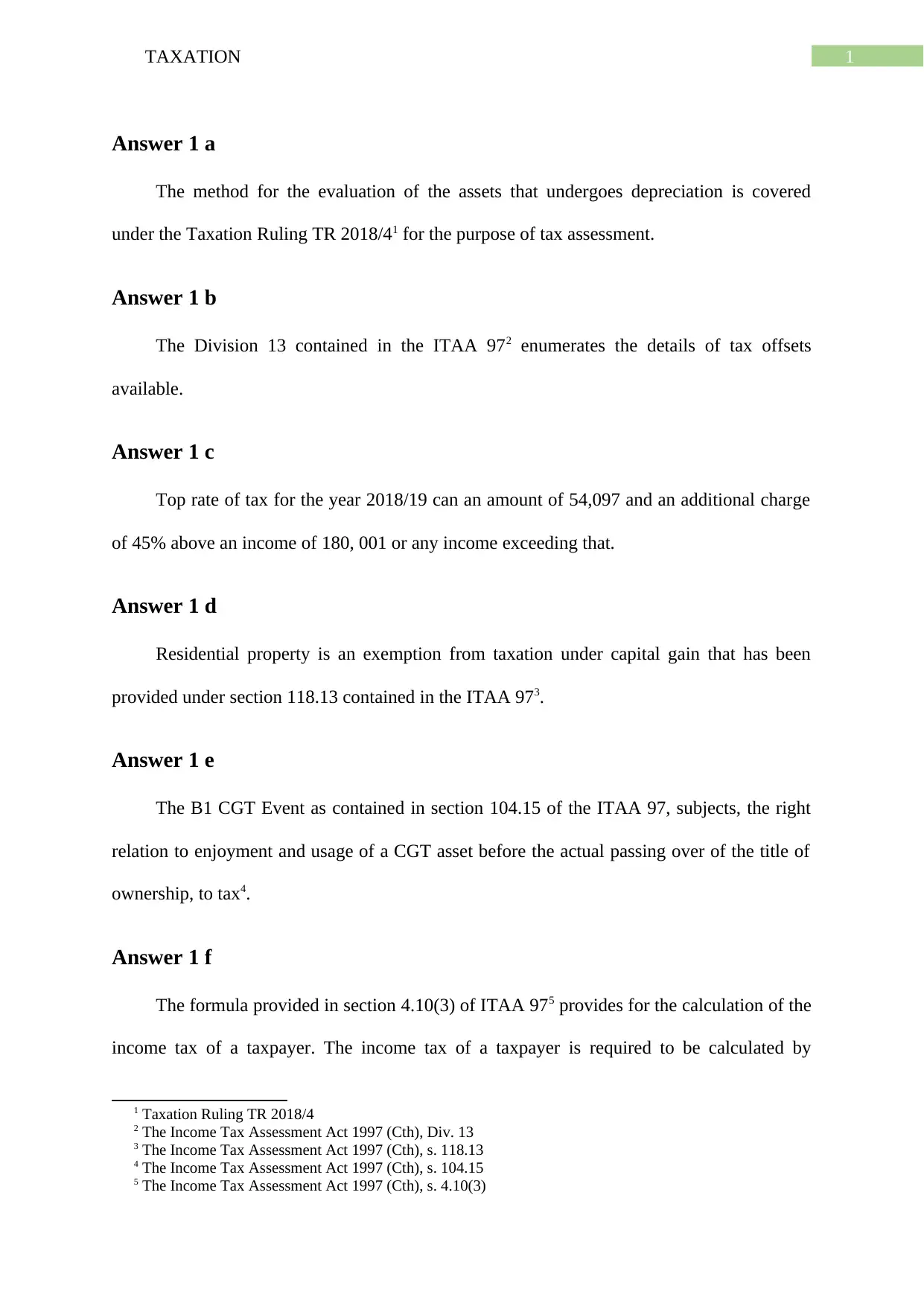
1TAXATION
Answer 1 a
The method for the evaluation of the assets that undergoes depreciation is covered
under the Taxation Ruling TR 2018/41 for the purpose of tax assessment.
Answer 1 b
The Division 13 contained in the ITAA 972 enumerates the details of tax offsets
available.
Answer 1 c
Top rate of tax for the year 2018/19 can an amount of 54,097 and an additional charge
of 45% above an income of 180, 001 or any income exceeding that.
Answer 1 d
Residential property is an exemption from taxation under capital gain that has been
provided under section 118.13 contained in the ITAA 973.
Answer 1 e
The B1 CGT Event as contained in section 104.15 of the ITAA 97, subjects, the right
relation to enjoyment and usage of a CGT asset before the actual passing over of the title of
ownership, to tax4.
Answer 1 f
The formula provided in section 4.10(3) of ITAA 975 provides for the calculation of the
income tax of a taxpayer. The income tax of a taxpayer is required to be calculated by
1 Taxation Ruling TR 2018/4
2 The Income Tax Assessment Act 1997 (Cth), Div. 13
3 The Income Tax Assessment Act 1997 (Cth), s. 118.13
4 The Income Tax Assessment Act 1997 (Cth), s. 104.15
5 The Income Tax Assessment Act 1997 (Cth), s. 4.10(3)
Answer 1 a
The method for the evaluation of the assets that undergoes depreciation is covered
under the Taxation Ruling TR 2018/41 for the purpose of tax assessment.
Answer 1 b
The Division 13 contained in the ITAA 972 enumerates the details of tax offsets
available.
Answer 1 c
Top rate of tax for the year 2018/19 can an amount of 54,097 and an additional charge
of 45% above an income of 180, 001 or any income exceeding that.
Answer 1 d
Residential property is an exemption from taxation under capital gain that has been
provided under section 118.13 contained in the ITAA 973.
Answer 1 e
The B1 CGT Event as contained in section 104.15 of the ITAA 97, subjects, the right
relation to enjoyment and usage of a CGT asset before the actual passing over of the title of
ownership, to tax4.
Answer 1 f
The formula provided in section 4.10(3) of ITAA 975 provides for the calculation of the
income tax of a taxpayer. The income tax of a taxpayer is required to be calculated by
1 Taxation Ruling TR 2018/4
2 The Income Tax Assessment Act 1997 (Cth), Div. 13
3 The Income Tax Assessment Act 1997 (Cth), s. 118.13
4 The Income Tax Assessment Act 1997 (Cth), s. 104.15
5 The Income Tax Assessment Act 1997 (Cth), s. 4.10(3)
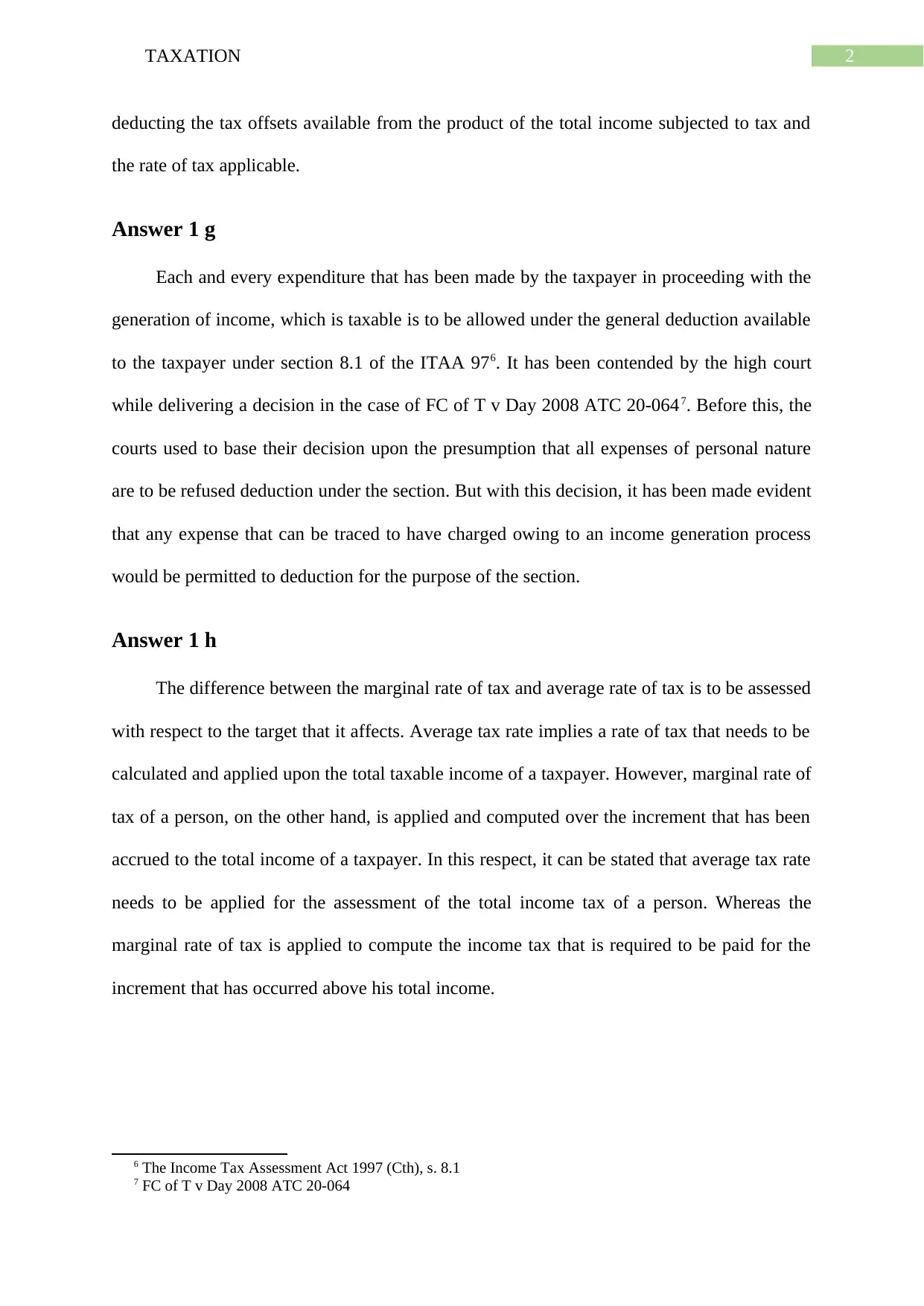
2TAXATION
deducting the tax offsets available from the product of the total income subjected to tax and
the rate of tax applicable.
Answer 1 g
Each and every expenditure that has been made by the taxpayer in proceeding with the
generation of income, which is taxable is to be allowed under the general deduction available
to the taxpayer under section 8.1 of the ITAA 976. It has been contended by the high court
while delivering a decision in the case of FC of T v Day 2008 ATC 20-0647. Before this, the
courts used to base their decision upon the presumption that all expenses of personal nature
are to be refused deduction under the section. But with this decision, it has been made evident
that any expense that can be traced to have charged owing to an income generation process
would be permitted to deduction for the purpose of the section.
Answer 1 h
The difference between the marginal rate of tax and average rate of tax is to be assessed
with respect to the target that it affects. Average tax rate implies a rate of tax that needs to be
calculated and applied upon the total taxable income of a taxpayer. However, marginal rate of
tax of a person, on the other hand, is applied and computed over the increment that has been
accrued to the total income of a taxpayer. In this respect, it can be stated that average tax rate
needs to be applied for the assessment of the total income tax of a person. Whereas the
marginal rate of tax is applied to compute the income tax that is required to be paid for the
increment that has occurred above his total income.
6 The Income Tax Assessment Act 1997 (Cth), s. 8.1
7 FC of T v Day 2008 ATC 20-064
deducting the tax offsets available from the product of the total income subjected to tax and
the rate of tax applicable.
Answer 1 g
Each and every expenditure that has been made by the taxpayer in proceeding with the
generation of income, which is taxable is to be allowed under the general deduction available
to the taxpayer under section 8.1 of the ITAA 976. It has been contended by the high court
while delivering a decision in the case of FC of T v Day 2008 ATC 20-0647. Before this, the
courts used to base their decision upon the presumption that all expenses of personal nature
are to be refused deduction under the section. But with this decision, it has been made evident
that any expense that can be traced to have charged owing to an income generation process
would be permitted to deduction for the purpose of the section.
Answer 1 h
The difference between the marginal rate of tax and average rate of tax is to be assessed
with respect to the target that it affects. Average tax rate implies a rate of tax that needs to be
calculated and applied upon the total taxable income of a taxpayer. However, marginal rate of
tax of a person, on the other hand, is applied and computed over the increment that has been
accrued to the total income of a taxpayer. In this respect, it can be stated that average tax rate
needs to be applied for the assessment of the total income tax of a person. Whereas the
marginal rate of tax is applied to compute the income tax that is required to be paid for the
increment that has occurred above his total income.
6 The Income Tax Assessment Act 1997 (Cth), s. 8.1
7 FC of T v Day 2008 ATC 20-064
⊘ This is a preview!⊘
Do you want full access?
Subscribe today to unlock all pages.

Trusted by 1+ million students worldwide
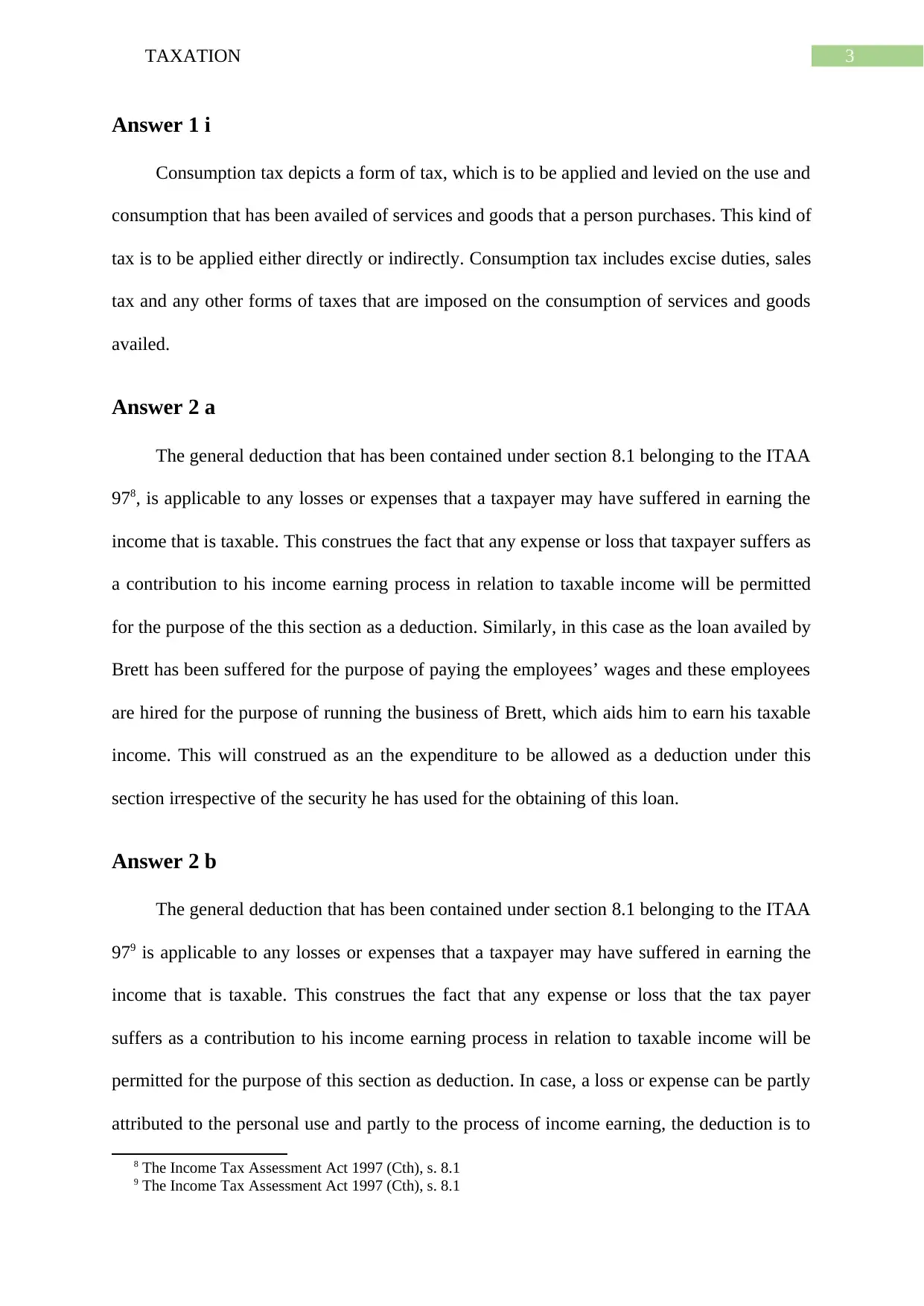
3TAXATION
Answer 1 i
Consumption tax depicts a form of tax, which is to be applied and levied on the use and
consumption that has been availed of services and goods that a person purchases. This kind of
tax is to be applied either directly or indirectly. Consumption tax includes excise duties, sales
tax and any other forms of taxes that are imposed on the consumption of services and goods
availed.
Answer 2 a
The general deduction that has been contained under section 8.1 belonging to the ITAA
978, is applicable to any losses or expenses that a taxpayer may have suffered in earning the
income that is taxable. This construes the fact that any expense or loss that taxpayer suffers as
a contribution to his income earning process in relation to taxable income will be permitted
for the purpose of the this section as a deduction. Similarly, in this case as the loan availed by
Brett has been suffered for the purpose of paying the employees’ wages and these employees
are hired for the purpose of running the business of Brett, which aids him to earn his taxable
income. This will construed as an the expenditure to be allowed as a deduction under this
section irrespective of the security he has used for the obtaining of this loan.
Answer 2 b
The general deduction that has been contained under section 8.1 belonging to the ITAA
979 is applicable to any losses or expenses that a taxpayer may have suffered in earning the
income that is taxable. This construes the fact that any expense or loss that the tax payer
suffers as a contribution to his income earning process in relation to taxable income will be
permitted for the purpose of this section as deduction. In case, a loss or expense can be partly
attributed to the personal use and partly to the process of income earning, the deduction is to
8 The Income Tax Assessment Act 1997 (Cth), s. 8.1
9 The Income Tax Assessment Act 1997 (Cth), s. 8.1
Answer 1 i
Consumption tax depicts a form of tax, which is to be applied and levied on the use and
consumption that has been availed of services and goods that a person purchases. This kind of
tax is to be applied either directly or indirectly. Consumption tax includes excise duties, sales
tax and any other forms of taxes that are imposed on the consumption of services and goods
availed.
Answer 2 a
The general deduction that has been contained under section 8.1 belonging to the ITAA
978, is applicable to any losses or expenses that a taxpayer may have suffered in earning the
income that is taxable. This construes the fact that any expense or loss that taxpayer suffers as
a contribution to his income earning process in relation to taxable income will be permitted
for the purpose of the this section as a deduction. Similarly, in this case as the loan availed by
Brett has been suffered for the purpose of paying the employees’ wages and these employees
are hired for the purpose of running the business of Brett, which aids him to earn his taxable
income. This will construed as an the expenditure to be allowed as a deduction under this
section irrespective of the security he has used for the obtaining of this loan.
Answer 2 b
The general deduction that has been contained under section 8.1 belonging to the ITAA
979 is applicable to any losses or expenses that a taxpayer may have suffered in earning the
income that is taxable. This construes the fact that any expense or loss that the tax payer
suffers as a contribution to his income earning process in relation to taxable income will be
permitted for the purpose of this section as deduction. In case, a loss or expense can be partly
attributed to the personal use and partly to the process of income earning, the deduction is to
8 The Income Tax Assessment Act 1997 (Cth), s. 8.1
9 The Income Tax Assessment Act 1997 (Cth), s. 8.1
Paraphrase This Document
Need a fresh take? Get an instant paraphrase of this document with our AI Paraphraser
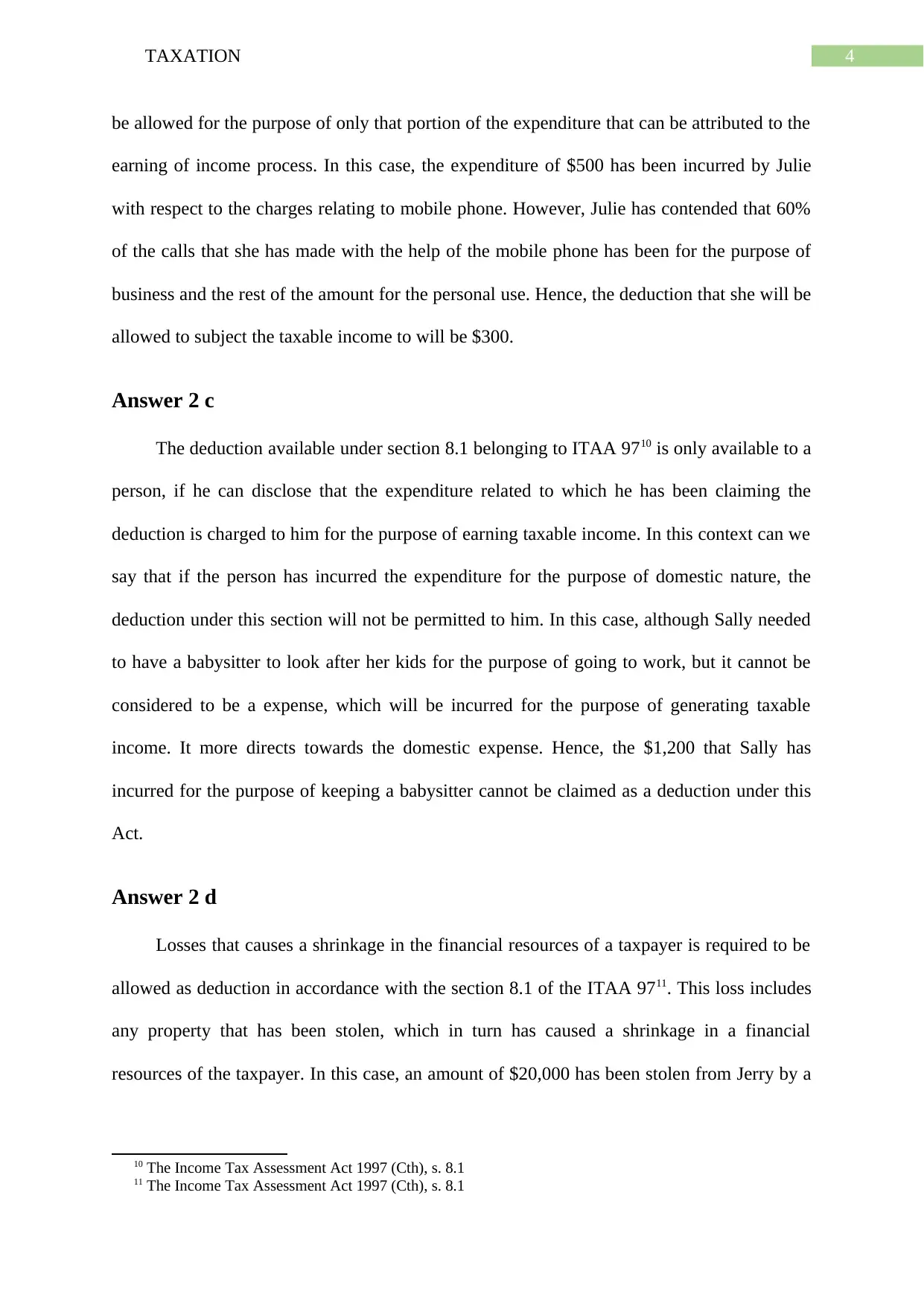
4TAXATION
be allowed for the purpose of only that portion of the expenditure that can be attributed to the
earning of income process. In this case, the expenditure of $500 has been incurred by Julie
with respect to the charges relating to mobile phone. However, Julie has contended that 60%
of the calls that she has made with the help of the mobile phone has been for the purpose of
business and the rest of the amount for the personal use. Hence, the deduction that she will be
allowed to subject the taxable income to will be $300.
Answer 2 c
The deduction available under section 8.1 belonging to ITAA 9710 is only available to a
person, if he can disclose that the expenditure related to which he has been claiming the
deduction is charged to him for the purpose of earning taxable income. In this context can we
say that if the person has incurred the expenditure for the purpose of domestic nature, the
deduction under this section will not be permitted to him. In this case, although Sally needed
to have a babysitter to look after her kids for the purpose of going to work, but it cannot be
considered to be a expense, which will be incurred for the purpose of generating taxable
income. It more directs towards the domestic expense. Hence, the $1,200 that Sally has
incurred for the purpose of keeping a babysitter cannot be claimed as a deduction under this
Act.
Answer 2 d
Losses that causes a shrinkage in the financial resources of a taxpayer is required to be
allowed as deduction in accordance with the section 8.1 of the ITAA 9711. This loss includes
any property that has been stolen, which in turn has caused a shrinkage in a financial
resources of the taxpayer. In this case, an amount of $20,000 has been stolen from Jerry by a
10 The Income Tax Assessment Act 1997 (Cth), s. 8.1
11 The Income Tax Assessment Act 1997 (Cth), s. 8.1
be allowed for the purpose of only that portion of the expenditure that can be attributed to the
earning of income process. In this case, the expenditure of $500 has been incurred by Julie
with respect to the charges relating to mobile phone. However, Julie has contended that 60%
of the calls that she has made with the help of the mobile phone has been for the purpose of
business and the rest of the amount for the personal use. Hence, the deduction that she will be
allowed to subject the taxable income to will be $300.
Answer 2 c
The deduction available under section 8.1 belonging to ITAA 9710 is only available to a
person, if he can disclose that the expenditure related to which he has been claiming the
deduction is charged to him for the purpose of earning taxable income. In this context can we
say that if the person has incurred the expenditure for the purpose of domestic nature, the
deduction under this section will not be permitted to him. In this case, although Sally needed
to have a babysitter to look after her kids for the purpose of going to work, but it cannot be
considered to be a expense, which will be incurred for the purpose of generating taxable
income. It more directs towards the domestic expense. Hence, the $1,200 that Sally has
incurred for the purpose of keeping a babysitter cannot be claimed as a deduction under this
Act.
Answer 2 d
Losses that causes a shrinkage in the financial resources of a taxpayer is required to be
allowed as deduction in accordance with the section 8.1 of the ITAA 9711. This loss includes
any property that has been stolen, which in turn has caused a shrinkage in a financial
resources of the taxpayer. In this case, an amount of $20,000 has been stolen from Jerry by a
10 The Income Tax Assessment Act 1997 (Cth), s. 8.1
11 The Income Tax Assessment Act 1997 (Cth), s. 8.1
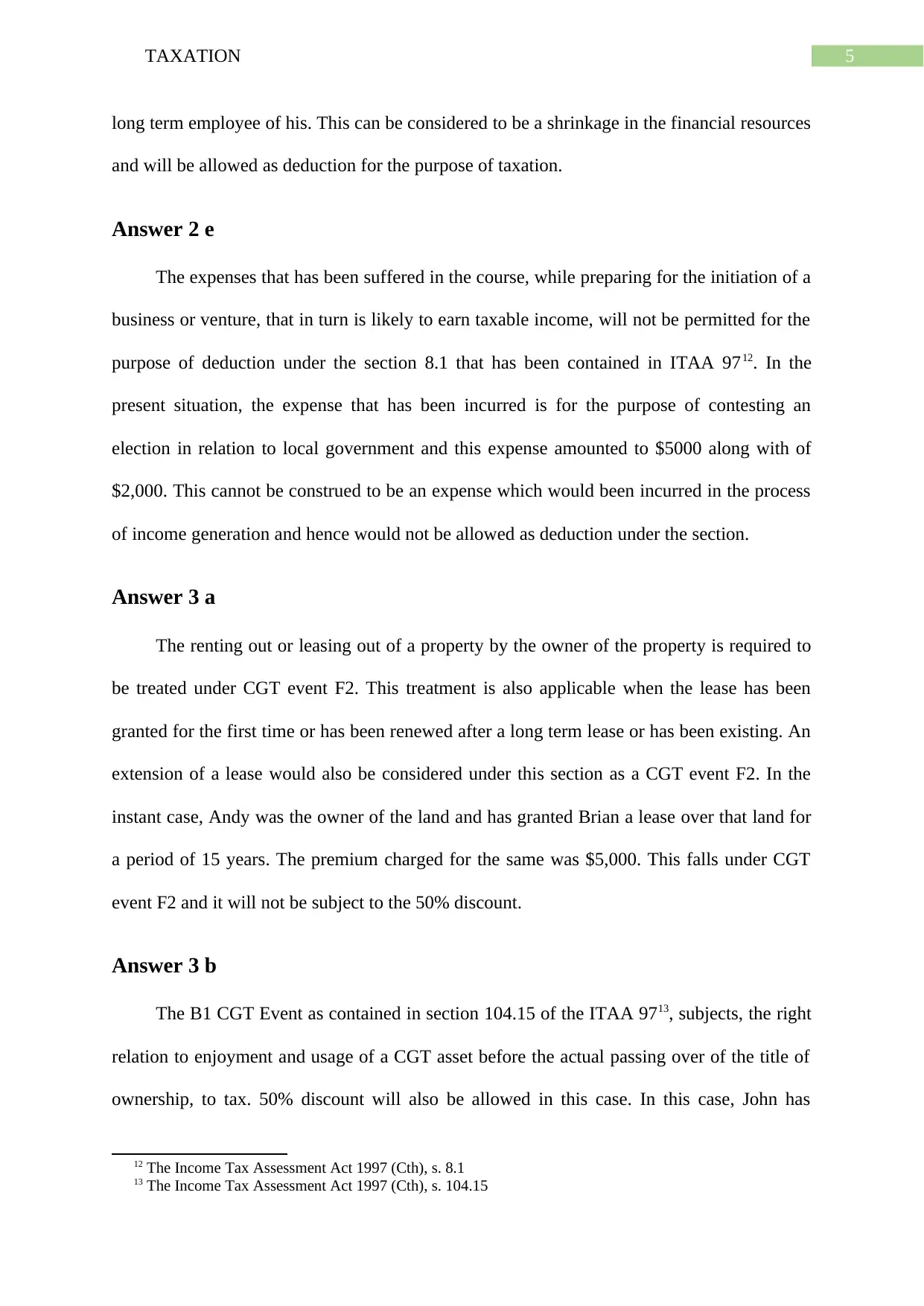
5TAXATION
long term employee of his. This can be considered to be a shrinkage in the financial resources
and will be allowed as deduction for the purpose of taxation.
Answer 2 e
The expenses that has been suffered in the course, while preparing for the initiation of a
business or venture, that in turn is likely to earn taxable income, will not be permitted for the
purpose of deduction under the section 8.1 that has been contained in ITAA 9712. In the
present situation, the expense that has been incurred is for the purpose of contesting an
election in relation to local government and this expense amounted to $5000 along with of
$2,000. This cannot be construed to be an expense which would been incurred in the process
of income generation and hence would not be allowed as deduction under the section.
Answer 3 a
The renting out or leasing out of a property by the owner of the property is required to
be treated under CGT event F2. This treatment is also applicable when the lease has been
granted for the first time or has been renewed after a long term lease or has been existing. An
extension of a lease would also be considered under this section as a CGT event F2. In the
instant case, Andy was the owner of the land and has granted Brian a lease over that land for
a period of 15 years. The premium charged for the same was $5,000. This falls under CGT
event F2 and it will not be subject to the 50% discount.
Answer 3 b
The B1 CGT Event as contained in section 104.15 of the ITAA 9713, subjects, the right
relation to enjoyment and usage of a CGT asset before the actual passing over of the title of
ownership, to tax. 50% discount will also be allowed in this case. In this case, John has
12 The Income Tax Assessment Act 1997 (Cth), s. 8.1
13 The Income Tax Assessment Act 1997 (Cth), s. 104.15
long term employee of his. This can be considered to be a shrinkage in the financial resources
and will be allowed as deduction for the purpose of taxation.
Answer 2 e
The expenses that has been suffered in the course, while preparing for the initiation of a
business or venture, that in turn is likely to earn taxable income, will not be permitted for the
purpose of deduction under the section 8.1 that has been contained in ITAA 9712. In the
present situation, the expense that has been incurred is for the purpose of contesting an
election in relation to local government and this expense amounted to $5000 along with of
$2,000. This cannot be construed to be an expense which would been incurred in the process
of income generation and hence would not be allowed as deduction under the section.
Answer 3 a
The renting out or leasing out of a property by the owner of the property is required to
be treated under CGT event F2. This treatment is also applicable when the lease has been
granted for the first time or has been renewed after a long term lease or has been existing. An
extension of a lease would also be considered under this section as a CGT event F2. In the
instant case, Andy was the owner of the land and has granted Brian a lease over that land for
a period of 15 years. The premium charged for the same was $5,000. This falls under CGT
event F2 and it will not be subject to the 50% discount.
Answer 3 b
The B1 CGT Event as contained in section 104.15 of the ITAA 9713, subjects, the right
relation to enjoyment and usage of a CGT asset before the actual passing over of the title of
ownership, to tax. 50% discount will also be allowed in this case. In this case, John has
12 The Income Tax Assessment Act 1997 (Cth), s. 8.1
13 The Income Tax Assessment Act 1997 (Cth), s. 104.15
⊘ This is a preview!⊘
Do you want full access?
Subscribe today to unlock all pages.

Trusted by 1+ million students worldwide
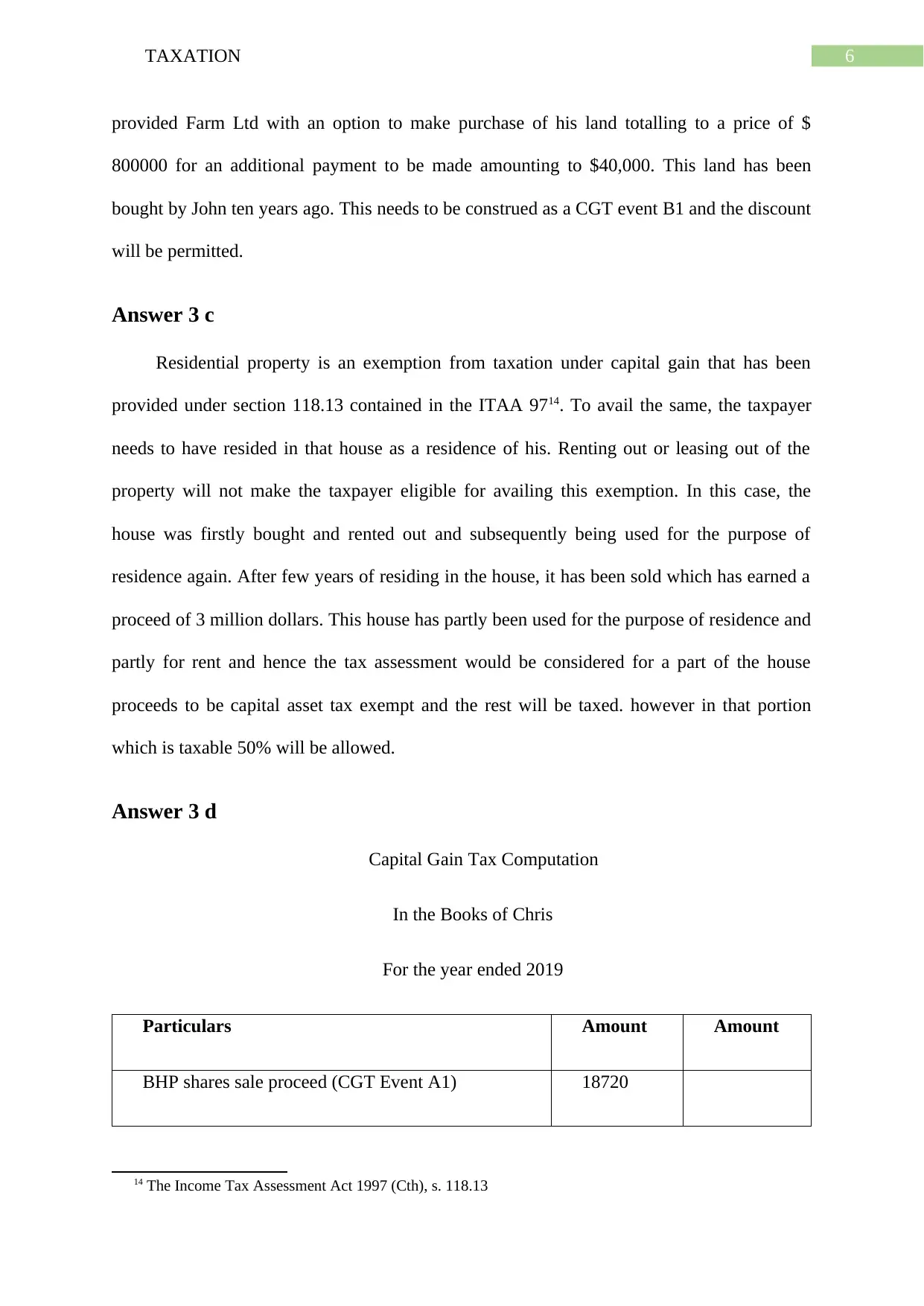
6TAXATION
provided Farm Ltd with an option to make purchase of his land totalling to a price of $
800000 for an additional payment to be made amounting to $40,000. This land has been
bought by John ten years ago. This needs to be construed as a CGT event B1 and the discount
will be permitted.
Answer 3 c
Residential property is an exemption from taxation under capital gain that has been
provided under section 118.13 contained in the ITAA 9714. To avail the same, the taxpayer
needs to have resided in that house as a residence of his. Renting out or leasing out of the
property will not make the taxpayer eligible for availing this exemption. In this case, the
house was firstly bought and rented out and subsequently being used for the purpose of
residence again. After few years of residing in the house, it has been sold which has earned a
proceed of 3 million dollars. This house has partly been used for the purpose of residence and
partly for rent and hence the tax assessment would be considered for a part of the house
proceeds to be capital asset tax exempt and the rest will be taxed. however in that portion
which is taxable 50% will be allowed.
Answer 3 d
Capital Gain Tax Computation
In the Books of Chris
For the year ended 2019
Particulars Amount Amount
BHP shares sale proceed (CGT Event A1) 18720
14 The Income Tax Assessment Act 1997 (Cth), s. 118.13
provided Farm Ltd with an option to make purchase of his land totalling to a price of $
800000 for an additional payment to be made amounting to $40,000. This land has been
bought by John ten years ago. This needs to be construed as a CGT event B1 and the discount
will be permitted.
Answer 3 c
Residential property is an exemption from taxation under capital gain that has been
provided under section 118.13 contained in the ITAA 9714. To avail the same, the taxpayer
needs to have resided in that house as a residence of his. Renting out or leasing out of the
property will not make the taxpayer eligible for availing this exemption. In this case, the
house was firstly bought and rented out and subsequently being used for the purpose of
residence again. After few years of residing in the house, it has been sold which has earned a
proceed of 3 million dollars. This house has partly been used for the purpose of residence and
partly for rent and hence the tax assessment would be considered for a part of the house
proceeds to be capital asset tax exempt and the rest will be taxed. however in that portion
which is taxable 50% will be allowed.
Answer 3 d
Capital Gain Tax Computation
In the Books of Chris
For the year ended 2019
Particulars Amount Amount
BHP shares sale proceed (CGT Event A1) 18720
14 The Income Tax Assessment Act 1997 (Cth), s. 118.13
Paraphrase This Document
Need a fresh take? Get an instant paraphrase of this document with our AI Paraphraser
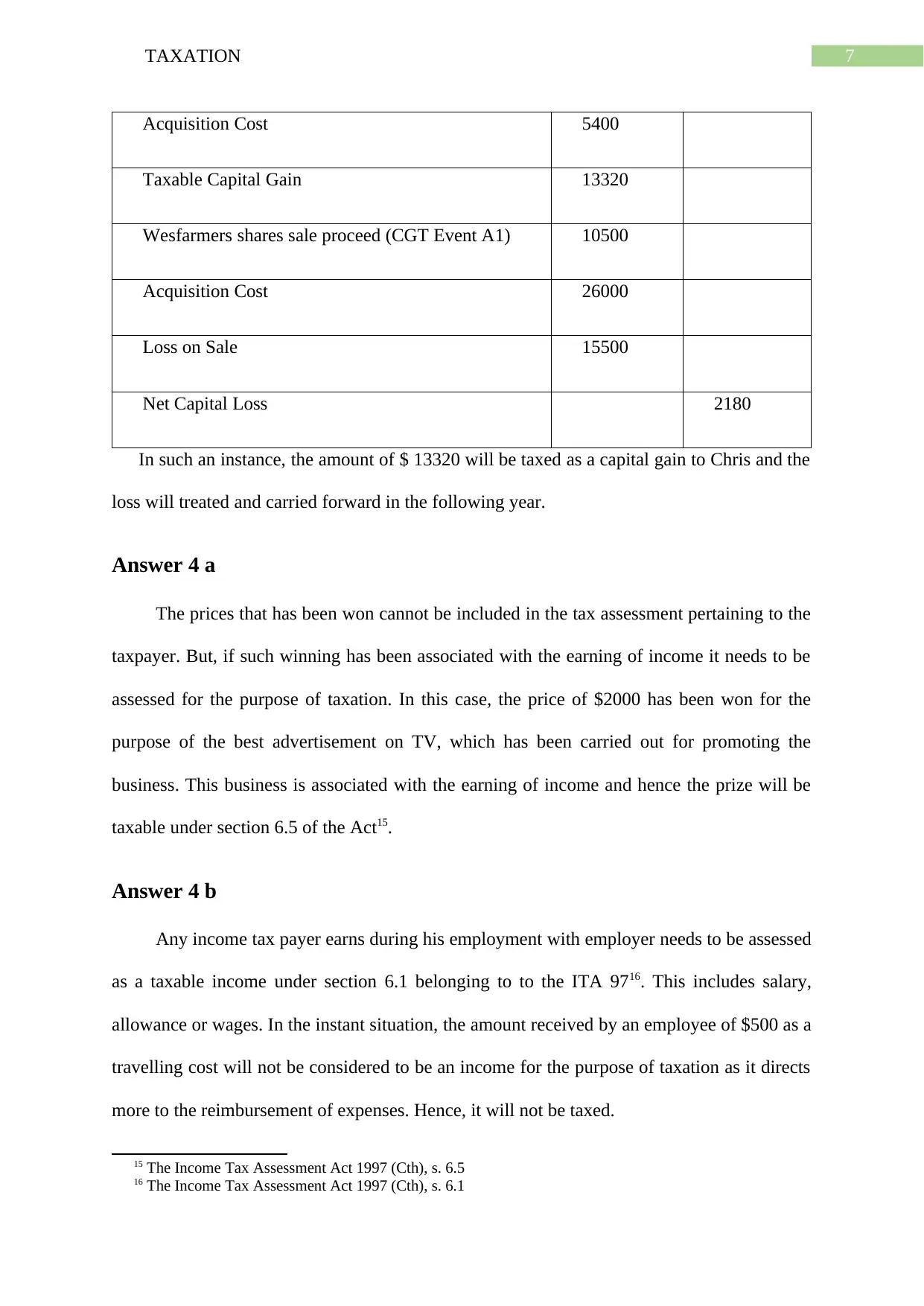
7TAXATION
Acquisition Cost 5400
Taxable Capital Gain 13320
Wesfarmers shares sale proceed (CGT Event A1) 10500
Acquisition Cost 26000
Loss on Sale 15500
Net Capital Loss 2180
In such an instance, the amount of $ 13320 will be taxed as a capital gain to Chris and the
loss will treated and carried forward in the following year.
Answer 4 a
The prices that has been won cannot be included in the tax assessment pertaining to the
taxpayer. But, if such winning has been associated with the earning of income it needs to be
assessed for the purpose of taxation. In this case, the price of $2000 has been won for the
purpose of the best advertisement on TV, which has been carried out for promoting the
business. This business is associated with the earning of income and hence the prize will be
taxable under section 6.5 of the Act15.
Answer 4 b
Any income tax payer earns during his employment with employer needs to be assessed
as a taxable income under section 6.1 belonging to to the ITA 9716. This includes salary,
allowance or wages. In the instant situation, the amount received by an employee of $500 as a
travelling cost will not be considered to be an income for the purpose of taxation as it directs
more to the reimbursement of expenses. Hence, it will not be taxed.
15 The Income Tax Assessment Act 1997 (Cth), s. 6.5
16 The Income Tax Assessment Act 1997 (Cth), s. 6.1
Acquisition Cost 5400
Taxable Capital Gain 13320
Wesfarmers shares sale proceed (CGT Event A1) 10500
Acquisition Cost 26000
Loss on Sale 15500
Net Capital Loss 2180
In such an instance, the amount of $ 13320 will be taxed as a capital gain to Chris and the
loss will treated and carried forward in the following year.
Answer 4 a
The prices that has been won cannot be included in the tax assessment pertaining to the
taxpayer. But, if such winning has been associated with the earning of income it needs to be
assessed for the purpose of taxation. In this case, the price of $2000 has been won for the
purpose of the best advertisement on TV, which has been carried out for promoting the
business. This business is associated with the earning of income and hence the prize will be
taxable under section 6.5 of the Act15.
Answer 4 b
Any income tax payer earns during his employment with employer needs to be assessed
as a taxable income under section 6.1 belonging to to the ITA 9716. This includes salary,
allowance or wages. In the instant situation, the amount received by an employee of $500 as a
travelling cost will not be considered to be an income for the purpose of taxation as it directs
more to the reimbursement of expenses. Hence, it will not be taxed.
15 The Income Tax Assessment Act 1997 (Cth), s. 6.5
16 The Income Tax Assessment Act 1997 (Cth), s. 6.1
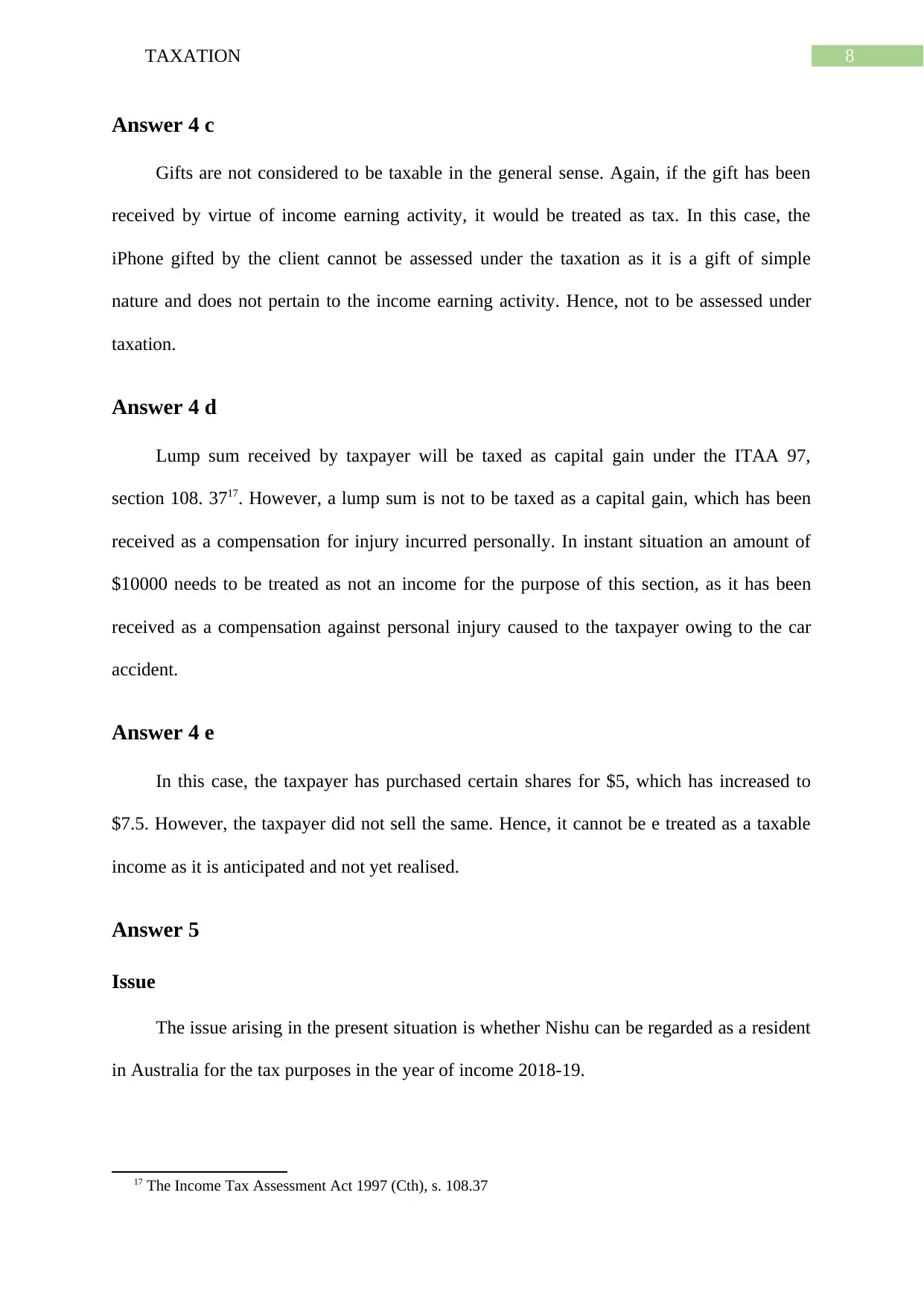
8TAXATION
Answer 4 c
Gifts are not considered to be taxable in the general sense. Again, if the gift has been
received by virtue of income earning activity, it would be treated as tax. In this case, the
iPhone gifted by the client cannot be assessed under the taxation as it is a gift of simple
nature and does not pertain to the income earning activity. Hence, not to be assessed under
taxation.
Answer 4 d
Lump sum received by taxpayer will be taxed as capital gain under the ITAA 97,
section 108. 3717. However, a lump sum is not to be taxed as a capital gain, which has been
received as a compensation for injury incurred personally. In instant situation an amount of
$10000 needs to be treated as not an income for the purpose of this section, as it has been
received as a compensation against personal injury caused to the taxpayer owing to the car
accident.
Answer 4 e
In this case, the taxpayer has purchased certain shares for $5, which has increased to
$7.5. However, the taxpayer did not sell the same. Hence, it cannot be e treated as a taxable
income as it is anticipated and not yet realised.
Answer 5
Issue
The issue arising in the present situation is whether Nishu can be regarded as a resident
in Australia for the tax purposes in the year of income 2018-19.
17 The Income Tax Assessment Act 1997 (Cth), s. 108.37
Answer 4 c
Gifts are not considered to be taxable in the general sense. Again, if the gift has been
received by virtue of income earning activity, it would be treated as tax. In this case, the
iPhone gifted by the client cannot be assessed under the taxation as it is a gift of simple
nature and does not pertain to the income earning activity. Hence, not to be assessed under
taxation.
Answer 4 d
Lump sum received by taxpayer will be taxed as capital gain under the ITAA 97,
section 108. 3717. However, a lump sum is not to be taxed as a capital gain, which has been
received as a compensation for injury incurred personally. In instant situation an amount of
$10000 needs to be treated as not an income for the purpose of this section, as it has been
received as a compensation against personal injury caused to the taxpayer owing to the car
accident.
Answer 4 e
In this case, the taxpayer has purchased certain shares for $5, which has increased to
$7.5. However, the taxpayer did not sell the same. Hence, it cannot be e treated as a taxable
income as it is anticipated and not yet realised.
Answer 5
Issue
The issue arising in the present situation is whether Nishu can be regarded as a resident
in Australia for the tax purposes in the year of income 2018-19.
17 The Income Tax Assessment Act 1997 (Cth), s. 108.37
⊘ This is a preview!⊘
Do you want full access?
Subscribe today to unlock all pages.

Trusted by 1+ million students worldwide
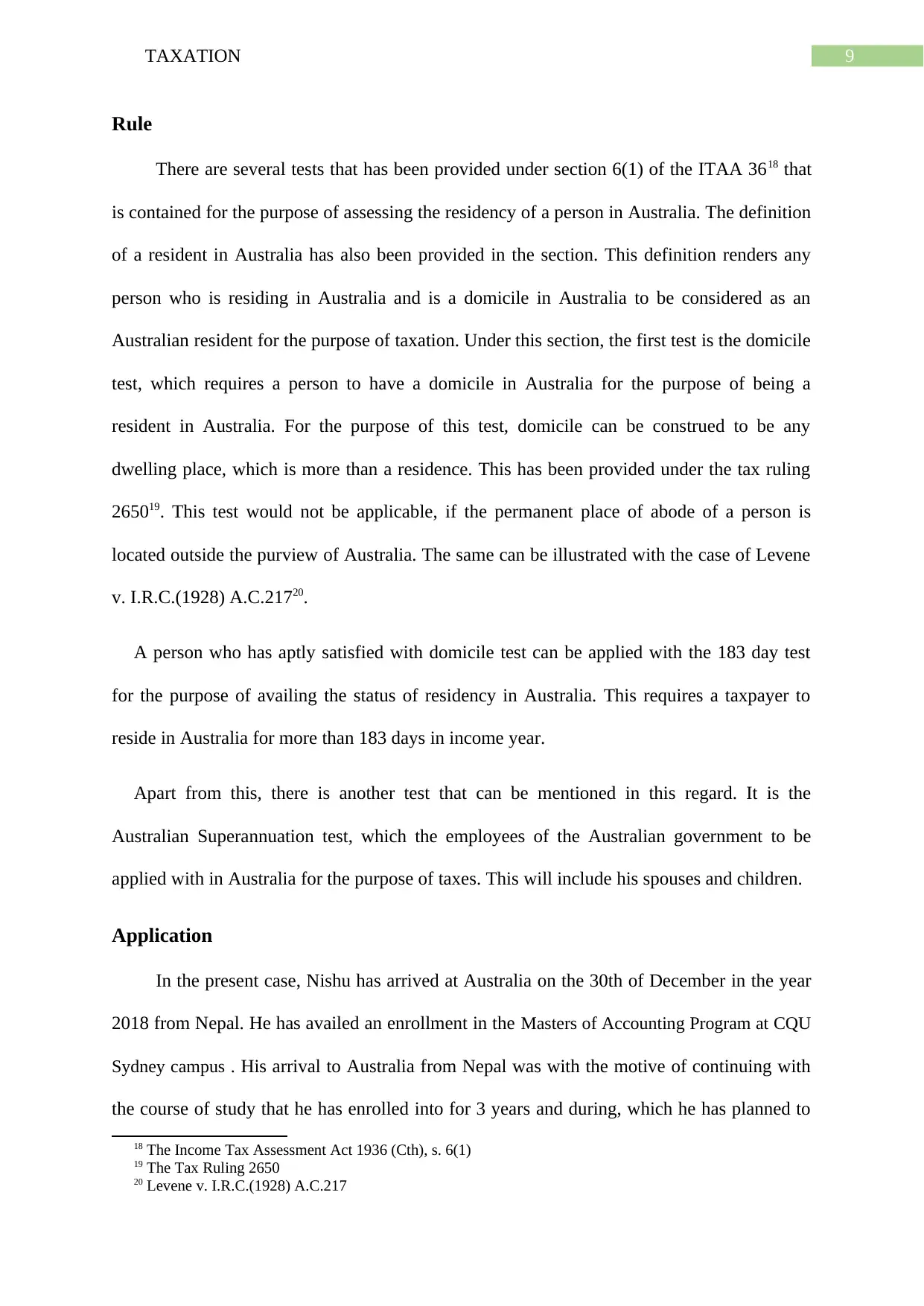
9TAXATION
Rule
There are several tests that has been provided under section 6(1) of the ITAA 3618 that
is contained for the purpose of assessing the residency of a person in Australia. The definition
of a resident in Australia has also been provided in the section. This definition renders any
person who is residing in Australia and is a domicile in Australia to be considered as an
Australian resident for the purpose of taxation. Under this section, the first test is the domicile
test, which requires a person to have a domicile in Australia for the purpose of being a
resident in Australia. For the purpose of this test, domicile can be construed to be any
dwelling place, which is more than a residence. This has been provided under the tax ruling
265019. This test would not be applicable, if the permanent place of abode of a person is
located outside the purview of Australia. The same can be illustrated with the case of Levene
v. I.R.C.(1928) A.C.21720.
A person who has aptly satisfied with domicile test can be applied with the 183 day test
for the purpose of availing the status of residency in Australia. This requires a taxpayer to
reside in Australia for more than 183 days in income year.
Apart from this, there is another test that can be mentioned in this regard. It is the
Australian Superannuation test, which the employees of the Australian government to be
applied with in Australia for the purpose of taxes. This will include his spouses and children.
Application
In the present case, Nishu has arrived at Australia on the 30th of December in the year
2018 from Nepal. He has availed an enrollment in the Masters of Accounting Program at CQU
Sydney campus . His arrival to Australia from Nepal was with the motive of continuing with
the course of study that he has enrolled into for 3 years and during, which he has planned to
18 The Income Tax Assessment Act 1936 (Cth), s. 6(1)
19 The Tax Ruling 2650
20 Levene v. I.R.C.(1928) A.C.217
Rule
There are several tests that has been provided under section 6(1) of the ITAA 3618 that
is contained for the purpose of assessing the residency of a person in Australia. The definition
of a resident in Australia has also been provided in the section. This definition renders any
person who is residing in Australia and is a domicile in Australia to be considered as an
Australian resident for the purpose of taxation. Under this section, the first test is the domicile
test, which requires a person to have a domicile in Australia for the purpose of being a
resident in Australia. For the purpose of this test, domicile can be construed to be any
dwelling place, which is more than a residence. This has been provided under the tax ruling
265019. This test would not be applicable, if the permanent place of abode of a person is
located outside the purview of Australia. The same can be illustrated with the case of Levene
v. I.R.C.(1928) A.C.21720.
A person who has aptly satisfied with domicile test can be applied with the 183 day test
for the purpose of availing the status of residency in Australia. This requires a taxpayer to
reside in Australia for more than 183 days in income year.
Apart from this, there is another test that can be mentioned in this regard. It is the
Australian Superannuation test, which the employees of the Australian government to be
applied with in Australia for the purpose of taxes. This will include his spouses and children.
Application
In the present case, Nishu has arrived at Australia on the 30th of December in the year
2018 from Nepal. He has availed an enrollment in the Masters of Accounting Program at CQU
Sydney campus . His arrival to Australia from Nepal was with the motive of continuing with
the course of study that he has enrolled into for 3 years and during, which he has planned to
18 The Income Tax Assessment Act 1936 (Cth), s. 6(1)
19 The Tax Ruling 2650
20 Levene v. I.R.C.(1928) A.C.217
Paraphrase This Document
Need a fresh take? Get an instant paraphrase of this document with our AI Paraphraser
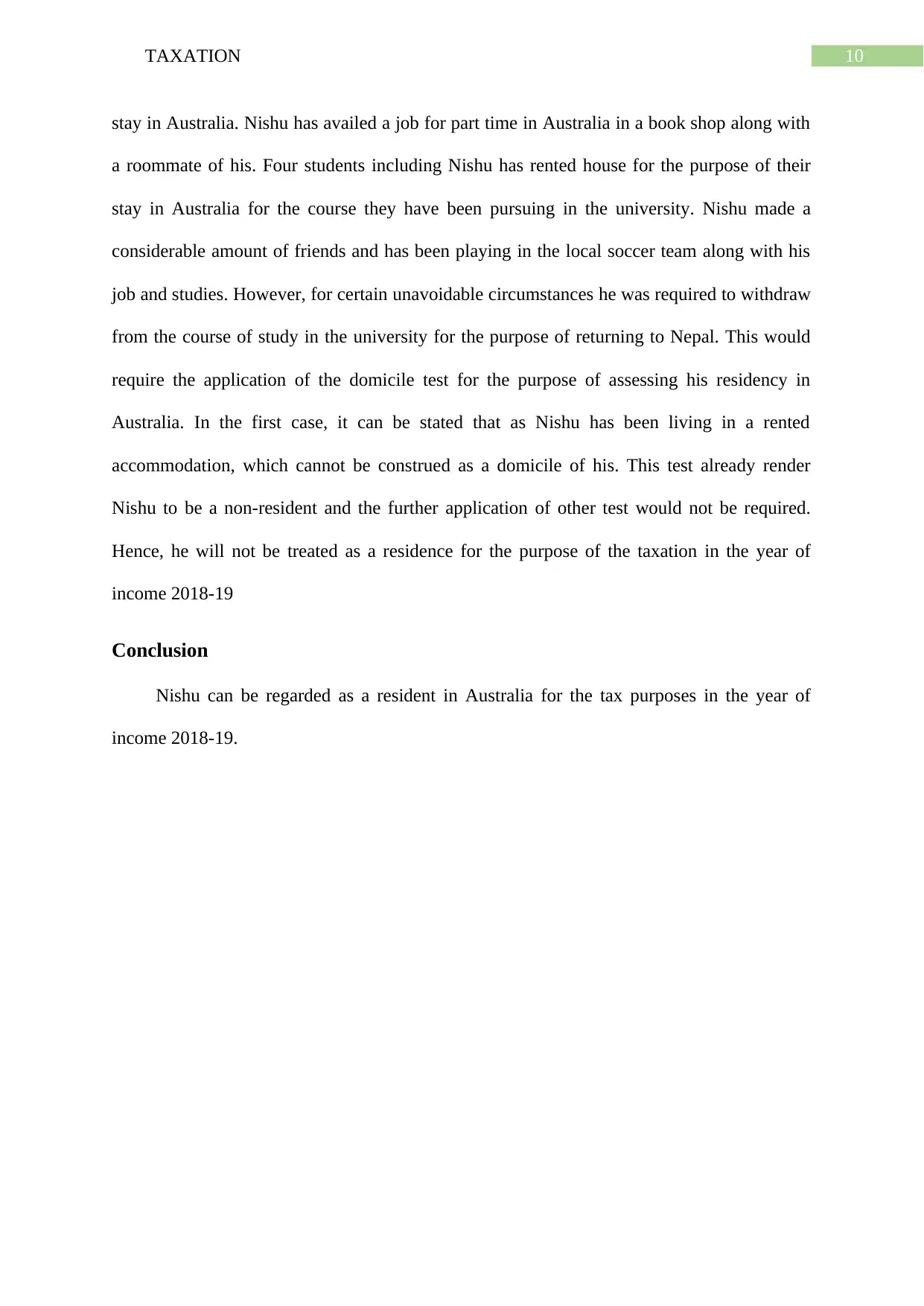
10TAXATION
stay in Australia. Nishu has availed a job for part time in Australia in a book shop along with
a roommate of his. Four students including Nishu has rented house for the purpose of their
stay in Australia for the course they have been pursuing in the university. Nishu made a
considerable amount of friends and has been playing in the local soccer team along with his
job and studies. However, for certain unavoidable circumstances he was required to withdraw
from the course of study in the university for the purpose of returning to Nepal. This would
require the application of the domicile test for the purpose of assessing his residency in
Australia. In the first case, it can be stated that as Nishu has been living in a rented
accommodation, which cannot be construed as a domicile of his. This test already render
Nishu to be a non-resident and the further application of other test would not be required.
Hence, he will not be treated as a residence for the purpose of the taxation in the year of
income 2018-19
Conclusion
Nishu can be regarded as a resident in Australia for the tax purposes in the year of
income 2018-19.
stay in Australia. Nishu has availed a job for part time in Australia in a book shop along with
a roommate of his. Four students including Nishu has rented house for the purpose of their
stay in Australia for the course they have been pursuing in the university. Nishu made a
considerable amount of friends and has been playing in the local soccer team along with his
job and studies. However, for certain unavoidable circumstances he was required to withdraw
from the course of study in the university for the purpose of returning to Nepal. This would
require the application of the domicile test for the purpose of assessing his residency in
Australia. In the first case, it can be stated that as Nishu has been living in a rented
accommodation, which cannot be construed as a domicile of his. This test already render
Nishu to be a non-resident and the further application of other test would not be required.
Hence, he will not be treated as a residence for the purpose of the taxation in the year of
income 2018-19
Conclusion
Nishu can be regarded as a resident in Australia for the tax purposes in the year of
income 2018-19.
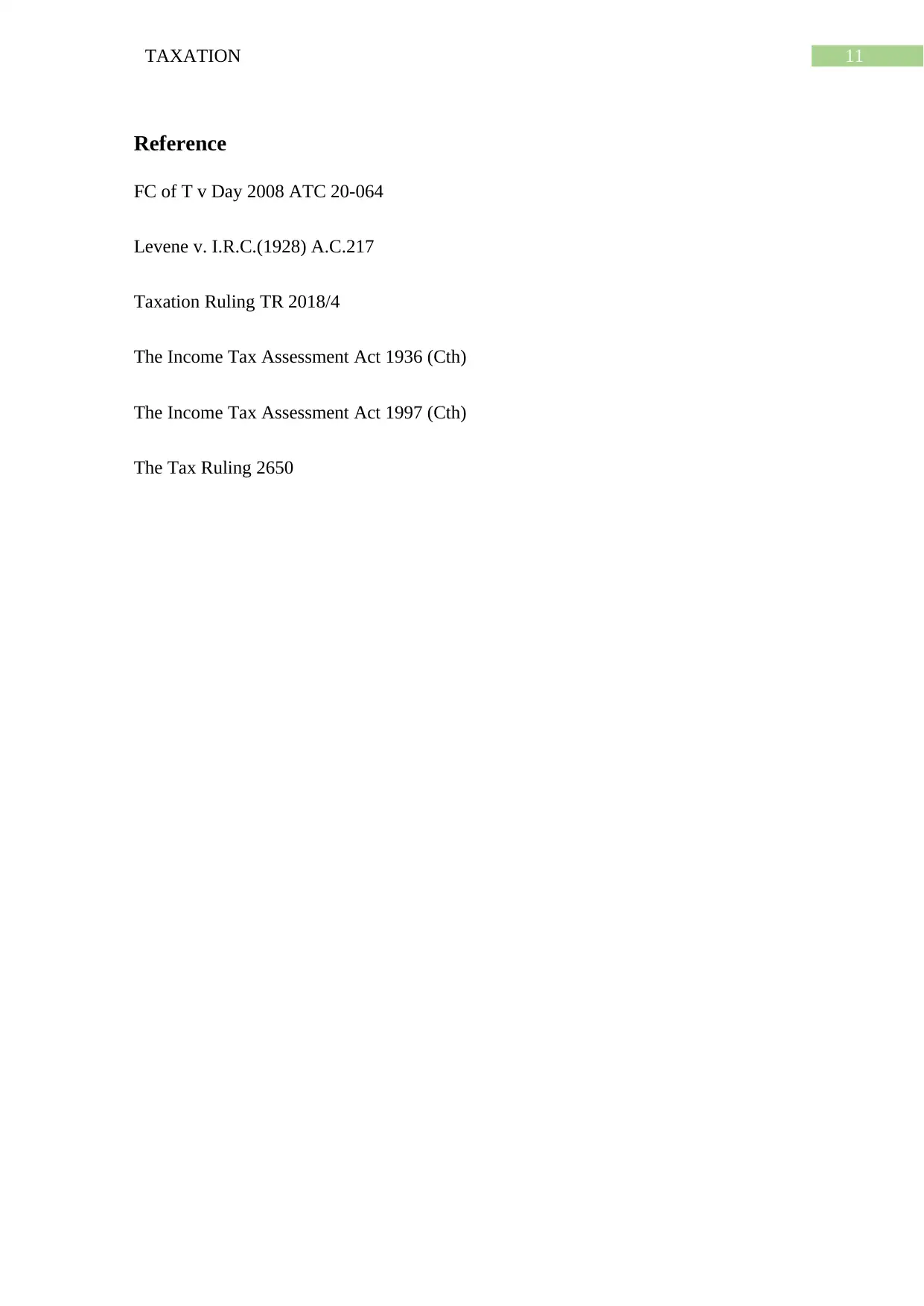
11TAXATION
Reference
FC of T v Day 2008 ATC 20-064
Levene v. I.R.C.(1928) A.C.217
Taxation Ruling TR 2018/4
The Income Tax Assessment Act 1936 (Cth)
The Income Tax Assessment Act 1997 (Cth)
The Tax Ruling 2650
Reference
FC of T v Day 2008 ATC 20-064
Levene v. I.R.C.(1928) A.C.217
Taxation Ruling TR 2018/4
The Income Tax Assessment Act 1936 (Cth)
The Income Tax Assessment Act 1997 (Cth)
The Tax Ruling 2650
⊘ This is a preview!⊘
Do you want full access?
Subscribe today to unlock all pages.

Trusted by 1+ million students worldwide
1 out of 12
Related Documents
Your All-in-One AI-Powered Toolkit for Academic Success.
+13062052269
info@desklib.com
Available 24*7 on WhatsApp / Email
![[object Object]](/_next/static/media/star-bottom.7253800d.svg)
Unlock your academic potential
Copyright © 2020–2025 A2Z Services. All Rights Reserved. Developed and managed by ZUCOL.





